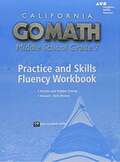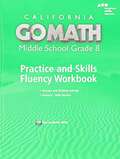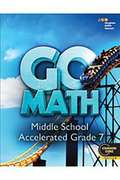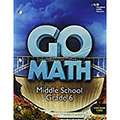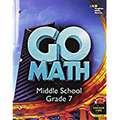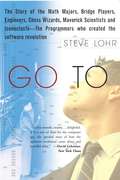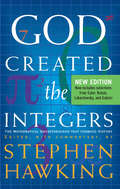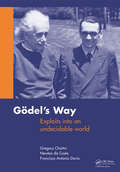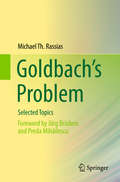- Table View
- List View
Go Math!, Grade 8, Middle School: Student Interactive Worktext (Go Math! STA)
by Timothy D. Kanold Edward B. Burger Juli K. DixonNIMAC-sourced textbook
Go Math!: Insuccess Student Edition Grade 4 (Gomath! Ser.)
by Houghton Mifflin Harcourt*This textbook has been transcribed in UEB, formatted according to Braille textbook formats, proofread and corrected. <P><P>
Go Math!: Practice Fluency Workbook Grade 7 (Go Math! Series)
by Holt McDougalath instruction is always evolving, with new approaches to pedagogy, engagement, and technology. GO Math!® meets students and teachers on their math journey, raising student achievement scores and supporting teachers along the way. <p><p> Designed by the same author team across K–8, GO Math! incorporates the latest thinking in its comprehensive approach and engages digital natives with cross-platform technology. It helps teachers to differentiate instruction, building and reinforcing foundational math skills that translate from the classroom to real life.
Go Math!: Practice Fluency Workbook Grade 8 (Go Math! Series)
by Holt McDougalMath instruction is always evolving, with new approaches to pedagogy, engagement, and technology. GO Math!® meets students and teachers on their math journey, raising student achievement scores and supporting teachers along the way. <p><p> Designed by the same author team across K–8, GO Math! incorporates the latest thinking in its comprehensive approach and engages digital natives with cross-platform technology. It helps teachers to differentiate instruction, building and reinforcing foundational math skills that translate from the classroom to real life.
Go Math!: Student Interactive Worktext (Grade #6)
by Timothy D. Kanold Edward B. Burger Juli K. DixonGo Math!: Student Interactive Worktext (Grade #8)
by Houghton Mifflin HarcourtGo Math!: Student Interactive Worktext (Grade 8)
Go Math!: Student Interactive Worktext Grade 8 2014 (Go Math! Ser.)
by Holt McdougalGo Math!: Student Interactive Worktext Grade 8
Go Math!: Student Interactive Worktext, Grade 7
by Houghton StaffHMH Go Math!: Student Interactive Worktext, Grade 7, 2018 Common Core Edition
Go Math, Grade 6, Middle School, Practice and Skills Fluency Workbook
by Houghton Mifflin HarcourtNIMAC-sourced textbook
Go Math, Grade 8, Middle School: Student Edition 2018 (Go Math! (StA))
by Timothy D. Kanold Edward B. Burger Juli K. DixonNIMAC-sourced textbook
Go Math, Middle School, Accelerated Grade 7
by Timothy D. Kanold Edward B. Burger Juli K. DixonNIMAC-sourced textbook
Go Math, Middle School, Grade 6
by Timothy D. Kanold Edward B. Burger Juli K. DixonNIMAC-sourced textbook
Go Math, Middle School, Grade 6
by Timothy D. Kanold Edward B. Burger Juli K. DixonNIMAC-sourced textbook
Go Math, Middle School, Grade 7
by Timothy D. Kanold Edward B. Burger Juli K. DixonNIMAC-sourced textbook
Go Math, Middle School, Grade 8
by Timothy D. Kanold Edward B. Burger Juli K. DixonNIMAC-sourced textbook
Go Math, Middle School, Grade 8
by Timothy D. Kanold Edward B. Burger Juli K. DixonNIMAC-sourced textbook
Go Math: Middle School, Grade 7
by Timothy D. Kanold Edward B. Burger Juli K. Dixon Steven J. Leinwand Matthew R. Larson Martha E. Sandoval-MartinezThis textbook for 7th graders covers essential math topics, with study guide reviews and assessments.
Go To: The Story of the Math Majors, Bridge Players, Engineers, Chess Wizards, Maverick Scientists and Iconoclasts- the Programmers Who Created the Software Revolution
by Steve LohrIn Go To, Steve Lohr chronicles the history of software from the early days of complex mathematical codes mastered by a few thousand to today's era of user-friendly software and over six million professional programmers worldwide. Lohr maps out the unique seductions of programming, and gives us an intimate portrait of the peculiar kind of genius that is drawn to this blend of art, science, and engineering, introducing us to the movers and shakers of the 1950s and the open-source movement of today. With original reporting and deft storytelling, Steve Lohr shows us how software transformed the world, and what it holds in store for our future.
God Created the Integers: The Mathematical Breakthroughs that Changed History
by Stephen HawkingBestselling author and physicist Stephen Hawking explores the masterpieces of mathematics, 25 landmarks spanning 2,500 years and representing the work of 15 mathematicians. "
God and the Mathematics of Infinity: What Irreducible Mathematics Says about Godhood
by H. Chris RansfordDrawing on the science and mathematics of infinity, H. Chris Ransford analyzes the traditional concept of godhood and reaches surprising conclusions. He addresses humankind's abiding core debate on the meaning of spirituality and God. Using mathematics, he explores key questions within this debate: for instance, why does evil exist if there is a God? The book fastidiously does not take sides nor proffers opinions, it only follows allowable mathematics wherever it leads. By doing so, it makes a major contribution to an understanding of the nature of reality.
Goedel's Way: Exploits into an undecidable world
by Gregory Chaitin Newton da Costa Francisco DoriaKurt Gödel (1906-1978) was an Austrian-American mathematician, who is best known for his incompleteness theorems. He was the greatest mathematical logician of the 20th century, with his contributions extending to Einstein’s general relativity, as he proved that Einstein’s theory allows for time machines.The Gödel incompleteness theorem - the usual formal mathematical systems cannot prove nor disprove all true mathematical sentences - is frequently presented in textbooks as something that happens in the rarefied realms of mathematical logic, and that has nothing to do with the real world. Practice shows the contrary though; one can demonstrate the validity of the phenomenon in various areas, ranging from chaos theory and physics to economics and even ecology. In this lively treatise, based on Chaitin’s groundbreaking work and on the da Costa-Doria results in physics, ecology, economics and computer science, the authors show that the Gödel incompleteness phenomenon can directly bear on the practice of science and perhaps on our everyday life.This accessible book gives a new, detailed and elementary explanation of the Gödel incompleteness theorems and presents the Chaitin results and their relation to the da Costa-Doria results, which are given in full, but with no technicalities. Besides theory, the historical report and personal stories about the main character and on this book’s writing process, make it appealing leisure reading for those interested in mathematics, logic, physics, philosophy and computer sciences. See also: http://www.youtube.com/watch?v=REy9noY5Sg8
Gold Medal Physics: The Science of Sports
by John Eric GoffNothing is quite as thrilling as watching superior athletes do the seemingly impossible. From Doug Flutie's "Hail Mary" pass to Lance Armstrong's record-breaking climb of Alp d'Huez to David Beckham's astounding ability to bend a soccer kick, we marvel and wonder, "How did they do that?" Well, physics professor John Eric Goff has the answers.This tour of the wide world of sports uses some of the most exhilarating feats in recent athletic history to make basic physics concepts accessible and fun. Goff discusses the science behind American football, soccer, cycling, skating, diving, long jumping, and a host of other competitive sports. Using elite athletes such as Greg Louganis and Bob Beamon as starting points, he explains in clear, lively language the basic physical properties involved in amazing and everyday athletic endeavors. Accompanied by illustrations and mathematical equations, each chapter builds on knowledge imparted in earlier portions of the book to provide a firm understanding of the concepts involved.Fun, witty, and imbued throughout with admiration for the simple beauty of physics, Gold Medal Physics is sure to inspire readers to think differently about the next sporting event they watch.
Gold Medal Physics: The Science of Sports
by John Eric GoffA physicist explains the science behind some of the greatest feats in sports history—from diving like Greg Louganis to bending it like Beckham.Nothing is quite as thrilling as watching superior athletes do the seemingly impossible. From Doug Flutie's "Hail Mary" pass to Lance Armstrong's record-breaking climb of Alp d'Huez to David Beckham's astounding ability to bend a soccer kick, we marvel and wonder, "How did they do that?" Well, physics professor John Eric Goff has the answers.In this scientific tour of the wide world of sports, John Eric Goff discusses the science behind American football, soccer, cycling, skating, diving, long jumping, and a host of other competitive sports. Using elite athletes as starting points, Goff explains the basic physical properties involved in amazing and everyday athletic endeavors. Accompanied by illustrations and mathematical equations, each chapter builds on knowledge imparted in earlier chapters to provide a firm understanding of the concepts involved.Fun, witty, and imbued throughout with admiration for the simple beauty of physics, Gold Medal Physics is sure to inspire readers to think differently about the next sporting event they watch.
Goldbach’s Problem
by Michael Th. RassiasImportant results surrounding the proof of Goldbach's ternary conjecture are presented in this book. Beginning with an historical perspective along with an overview of essential lemmas and theorems, this monograph moves on to a detailed proof of Vinogradov's theorem. The principles of the Hardy-Littlewood circle method are outlined and applied to Goldbach's ternary conjecture. New results due to H. Maier and the author on Vinogradov's theorem are proved under the assumption of the Riemann hypothesis. The final chapter discusses an approach to Goldbach's conjecture through theorems by L. G. Schnirelmann. This book concludes with an Appendix featuring a sketch of H. Helfgott's proof of Goldbach's ternary conjecture. The Appendix also presents some biographical remarks of mathematicians whose research has played a seminal role on the Goldbach ternary problem. The author's step-by-step approach makes this book accessible to those that have mastered classical number theory and fundamental notions of mathematical analysis. This book will be particularly useful to graduate students and mathematicians in analytic number theory, approximation theory as well as to researchers working on Goldbach's problem.
Golden Numbers: A California Number Book
by David DomeniconiCalifornia's symbols, facts, landscapes, and history are introduced using numbers. Each subject is introduced with a poem, followed by more detailed information. Topics include volcanoes, presidios, the desert tortoise, frogs, and monarch butterflies.

